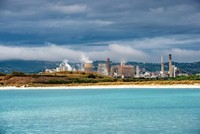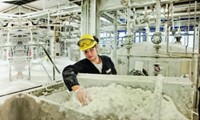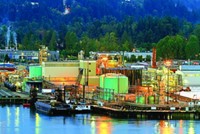Advertisement
Grab your lab coat. Let's get started
Welcome!
Welcome!
Create an account below to get 6 C&EN articles per month, receive newsletters and more - all free.
It seems this is your first time logging in online. Please enter the following information to continue.
As an ACS member you automatically get access to this site. All we need is few more details to create your reading experience.
Not you? Sign in with a different account.
Not you? Sign in with a different account.
ERROR 1
ERROR 1
ERROR 2
ERROR 2
ERROR 2
ERROR 2
ERROR 2
Password and Confirm password must match.
If you have an ACS member number, please enter it here so we can link this account to your membership. (optional)
ERROR 2
ACS values your privacy. By submitting your information, you are gaining access to C&EN and subscribing to our weekly newsletter. We use the information you provide to make your reading experience better, and we will never sell your data to third party members.
Business
Up From The Ashes
U.S. soda ash industry fights its way out of the recession
by Michael McCoy
September 7, 2009
| A version of this story appeared in
Volume 87, Issue 36

Thanks to the world economy’s big stumble, many commodity chemical sectors have experienced boom and bust over the past 12 months. Few have had it as bad as the U.S. soda ash business.
Last year was perhaps the best year ever for the U.S. soda ash industry. Prices reached an all-time high, and plants ran full out. But the combination of economic calamity and fierce competition from Chinese producers yielded a sudden period of hard times. Now, companies are leveraging their low-cost position in a fight to reverse it.
With U.S. production of 11.3 million metric tons last year, soda ash, or sodium carbonate, is one of the country’s largest volume inorganic chemicals. About half of that output is combined with sand and calcium carbonate to make glass. Other applications include laundry detergents, sodium bicarbonate production, and sundry applications calling for an alkaline material.
U.S. producers hold a coveted place in the global soda ash trade. Four out of five of them are based around Green River, Wyo., where they tap an ore called trona that is rich in sodium sesquicarbonate. The chemistry is simple. Calcining the sesquicarbonate splits off carbon dioxide, leaving a crude sodium carbonate that is then dissolved and precipitated in pure form.
Most of the rest of the world’s producers use one of several variations on the Solvay process, a multistep synthesis that starts with limestone, salt, and ammonia and ends up with soda ash and calcium chloride. A version of the process often practiced in China yields soda ash and ammonium chloride, which is used as a rice fertilizer.
Bill Breunig, director of sales and marketing at FMC Corp., the world’s largest natural soda ash producer with 4.85 million short tons per year of capacity in Wyoming, appreciates the uniqueness of the resource his company taps. “The Lord didn’t lay down a lot of trona around the world,” he says.
U.S. companies can make soda ash at half or even one-third the cost of their foreign rivals, according to Walter Clark, a longtime soda ash industry watcher who writes the monthly Trona Patch Times newsletter. One result is that 48% of the U.S. soda ash generated last year was exported to parts of the world that don’t enjoy such production economics.
Even that advantage doesn’t ensure healthy profits, though. In 2004, bruised by the attempted entry of a new competitor in Colorado, the industry saw the value of U.S. soda ash fall to less than $64 per short ton, a longtime low according to the U.S. Geological Survey.
But the newcomer, American Soda, faltered. It was bought by Solvay, one of the Wyoming companies, and eventually shut down. Aided by a strong economy, the U.S. industry recovered, and by 2008, the average soda ash price was $115 per short ton, a historic high. “The industry went from slim margins to a very profitable business,” Clark says.
Then the recession hit, and a cascade of misfortunes quickly rippled through the trona patch. Domestic glass companies, which claim the auto and construction industries as their major customers, saw demand slow to a crawl. The soda ash industry’s overseas customers, many of them also glassmakers, were hurt as well. Companies worldwide drew down inventories to save cash. And last but not least, China’s soda ash producers, long content to serve mainly local customers, suddenly started looking abroad to sustain sales.
As Clark explains it, this last development is giving the recession an extra bite for the U.S. soda ash industry. “The fear has always been that when the bloom came off the rose in China,” producers there “would flood the world with cheap soda ash,” he says. “Well, they did it.”
Compared with the Wyoming soda ash industry, which built up gradually since being established in 1948, the Chinese industry sprang up virtually overnight. According to Breunig, Chinese production was only about 3.5 million metric tons in 1990. Last year, the country produced close to 20 million metric tons.
Most of that production was consumed domestically by China’s booming construction and auto industries. But the recession hit China as well. In fact, when Breunig was there last fall, he was already seeing the impact. “Because of pollution concerns, the Olympics caused a lot of requests for businesses to slow down,” he says. “After the Olympics, industrial production never really got back to the way it was.”
Uncharacteristically, Breunig recalls, Chinese soda ash companies responded to the slowdown by cutting back on production. But that didn’t last long, and manufacturers eventually cranked production back up, exporting much of it in the absence of local demand.
According to figures compiled by Clark, monthly Chinese output peaked at 1.7 million metric tons in October 2008. It plummeted to 1.3 million metric tons in November and stayed low through February 2009. By April, though, it was back up almost to the peak of the previous October.
China’s aggressiveness took U.S. companies by surprise. The four Green River soda ash producers market their exports to the rest of the world, except Europe, Canada, and South Africa, through American Natural Soda Ash Corp., a legal export cartel. Until last fall, a robust global economy allowed ANSAC to steadily raise prices for exported soda ash while maintaining a sold-out sales position.
But the desire to hold on to those high prices blinded ANSAC to China’s encroachment in the export market. William G. Walter, FMC’s chief executive officer, admitted to stock analysts during an earnings conference call in May that ANSAC was “caught flat-footed in the first quarter and lost share in the export market.” He went on to say that the organization didn’t react quickly enough with price cuts when the export market turned soft.
“As the lowest cost supplier in the world, we should never be in a position where we’re not sold out,” Walter said. “ANSAC understands that and is working aggressively at it.”
The new export strategy is taking hold, Breunig claims, and even U.S. customers are starting to increase orders. U.S. demand will likely be off by 500,000 short tons this year, but he expects the export rate in the fourth quarter to be close to what it was during 2008.
In Breunig’s view, the U.S. soda ash industry’s response to the Chinese threat is an optimistic chapter in the otherwise gloomy story of the U.S. chemical industry these days. “We are now in gear,” he says. “We can put soda ash on a train, on an ocean vessel, and into Indonesia and gain share at the expense of China.”
Scott Schreiber, director of marketing and sales at OCI Chemical, another of the Wyoming soda ash producers, agrees that “demand is coming back.” OCI was forced to cut operating rates at its Green River plant by 20–30%, he says, but the firm is now starting to inch output back up in response to higher exports and a slight uptick in U.S. demand.
Still, damage was done in the process. In April, FMC idled one of its Wyoming soda ash plants, taking 600,000 short tons of capacity off-line and putting 70 employees out of work. The company had planned to restart the plant this year, but in July it said the restart would not happen until 2010 at the earliest.
Likewise, OCI said in July that it would lay off 38 soda ash plant employees, about an 8% staff cut. And although Schreiber is encouraged by exports and by improving demand from industries such as detergents and chemical manufacturing, he doesn’t see a return to the heyday of 2008 for several years. “It may never get back,” he says.
Regardless of what the future brings, for soda ash producers, 2009 has been a year to remember. “I’ve been in this business for a long time, and I’ve never seen as dramatic a turn down and then rise back up,” Breunig says. “Our cost position has allowed us to maneuver through this without some of the really catastrophic results we’ve seen in some of the other chemical industries.”






Join the conversation
Contact the reporter
Submit a Letter to the Editor for publication
Engage with us on Twitter